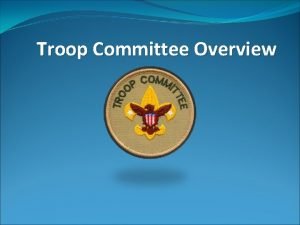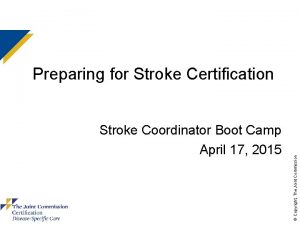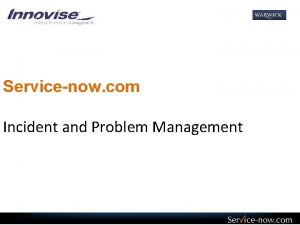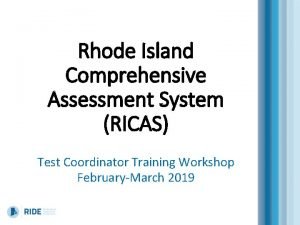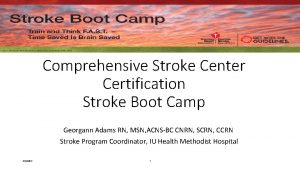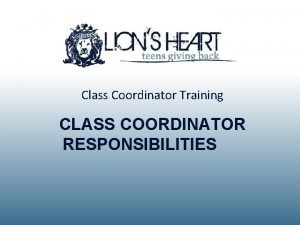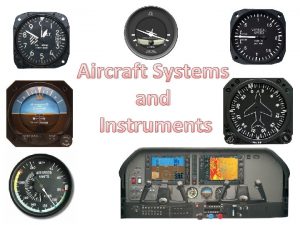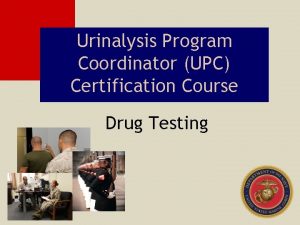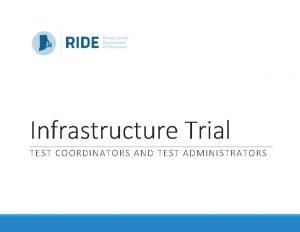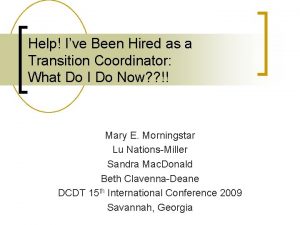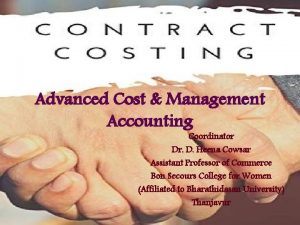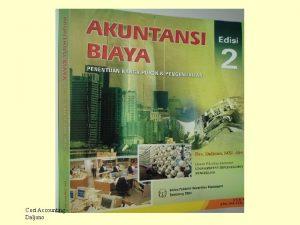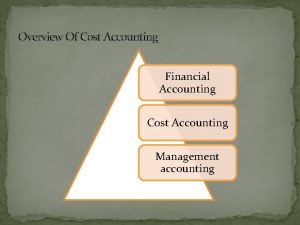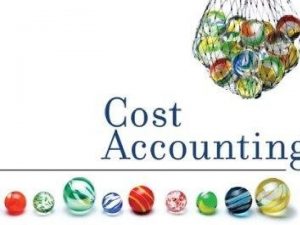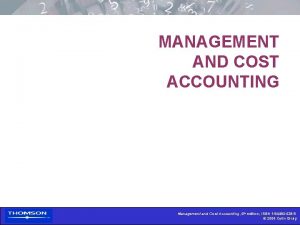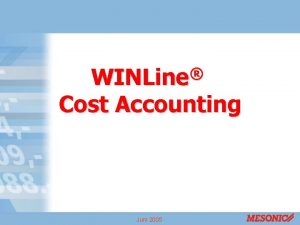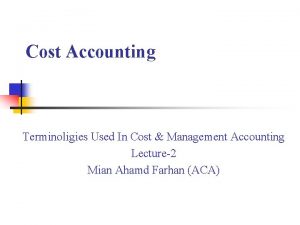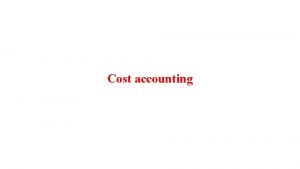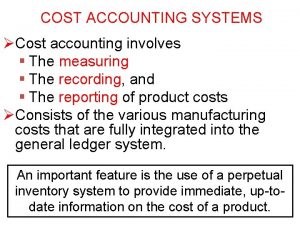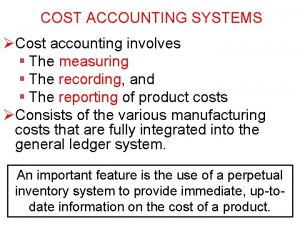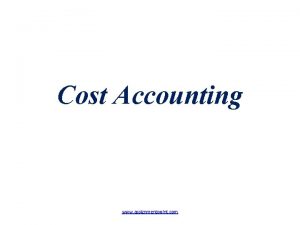Cost Accounting Coordinator Dr D Heena Cowsar Assistant














- Slides: 14

Cost Accounting Coordinator Dr. D. Heena Cowsar Assistant Professor of Commerce Bon Secours College for Women (Affiliated to Bharathidasan University) Thanjavur

ØContract It is an agreement signed between two parties namely Contractor & Contractee to accomplish the job agreed between them for profit within the stipulated period of time. ØContract Costing is a special type of job costing where the unit of cost is a single contract. The contract itself is a cost center and is executed under the customer’s specifications. Contract costing is a variant of job costing system applicable particularly in case of the organization’s doing construction work. It is also known as terminal costing. Each contract, short term or long term is treated as a job. It is one of the method of Costing and mainly applied in civil construction and engineering projects, ship building, road and railway line contracts, construction of bridges etc. It is a long time process, Where the work is executed at the customer’s site. As it takes number of years to complete a job, the problem of profit taking arises.

• CIMA defines Contract costing as follows “Contract costing is that form of specific order costing which applies where work is undertaken to customers’ special requirements and each order is of long-term duration”. Features of Contract costing 1. Materials 2. Wages 3. Direct Charges 4. Bill of Sub Contract 5. Certificate of Completion The work being of a constructional nature, the same is executed at the customer’s site, as per his specifications. ØMaterials The bulk of the materials purchased and delivered direct to the contract site or obtained from the central stores through the requisition slips. ØWages The wages which cannot be charged directly to any contract are treated as indirect wages that require apportionment. ØDirect Charges Most of the costs which are normally treated as indirect can be identified specifically with a particular contract and are charged to it as direct costs.

ØBill of sub-contractors Parts of large contracts are often done by third parties under sub-contracts. Subcontracts is a practice normally followed on the region of economy, specialized nature of work, want of capacity, etc. ØCertificate of completion The contracts do not pay the full value of the work certified as completed but retain a certain percent under the terms of the agreement. Objects Of Contract Costing The main objects of Contract Costing are: (i) to ascertain the total cost of a contract, and (ii) to ascertain the profit or loss on the contract. Types of Contract Costing Cost plus Contract Price of Contract is ascertained by adding a fixed amount of margin of profit to the total cost of Contract Fixed Price Contract Both Contractor and Contractee agrees to the fixed price of Contract Escalation Clause Mixture of Both Cost plus & Fixed Price Contract

1. Cost-plus contract Cost Plus Contract is a contract in which the value-of-the contract is ascertained by adding a fixed margin of profit to the total cost of the contract. In this case, the manufacturer is assured of a certain percentage of profit in advance and is protected against any fluctuations in the market prices of the various cost elements involved in the production. As a result of the viewpoint of the manufacturer, the possibility of incurring any loss is eliminated. 2. Fixed Price Contract Under Fixed-Price Contract the contractor and the contractee both parties agree to a fixed contract price. In this case, the manufacturer is not assured of a certain percentage of profit in advance and is not protected against any fluctuations in the market prices of the various cost elements involved in the production. 3. Contract with Escalation Cost It is a combination of both Cost –plus and Fixed price contract. Under this method the fixed price increase with the increase in the cost of materials, labour

Terminology of Contract Costing 1. Sub-contracts. The contractor (if thinks proper and allowed to do so by the agreement entered into) may entrust some portion of the work to be done by one or more than one sub-contractor. The cost in this connection is the direct charge on the contract and is treated as such in the contract costing. 2. Escalation Clause. In a contract agreement, there is a usual practice of making a provision for the escalation clause the contractor is interested in safeguarding himself against any charge in the price level. The agreement itself specifies the procedure for the calculation of adjustment in order to avoid all disputes etc. 3. Surveyor’s Certificate and Retention Money: In case of large contract which extends for more than a year it is normal practice to make payment against the portion of the contract completed on the basis of work certified by the contractee’s surveyor. The certificate issued by the surveyor (or technical assessor) in this respect is known as Surveyor’s Certificate. As per terms of the contract, full amount of the work certified is not paid to the contractor. A certain percentage (say 10% to 20%) of the amount is retained by the contractee and is paid sometime after the completion of the contract. The sum of money thus retained is known as Retention Money. This is done to give protection to the contractee in case the contractor does not fulfill the terms and conditions of the contract.

4. Uncertified Work: The work which has been done by the contractor but not certified by the architect on the date of accounting due to insufficient progress is known as Uncertified Work. In case of incomplete contract for which profit is required to be calculated, the value of uncertified work should be taken into account and it is justifiable to evaluate such work at cost. Because, it is not logical to calculate profit on the work which is not complete. Thus the Contract A/c is credited with this cost of uncertified work and Work-in-progresses debited with the same. This entry is reversed at the beginning of the next year. 5. Work-in-Progress Contract: Work-in-progress means incomplete contract which is in progress. The contractor may prepare a Work-in-progress A/c by debiting the account with the value of work certified and cost of uncertified work and by crediting the profit not transferred to Profit & Loss A/c (i. e. reserve profit). The difference between the two sides of the account less cash received is the work-in-progress, which is shown in the Balance Sheet. 6. Notional Profit: Notional means estimate. As completion of contracts take several years, wide fluctuations may be noted in the profit figures of contractors from year to year. Notional Profit=value of work certified-cost of work certified

Profit of Incomplete Contract 1. Profit should be considered in respect of work certified only; work uncertified should always be valued at cost. 2. Recently Stated If the work started recently and onefourth or less is done no profit should be transferred to profit and loss account. 3. More than 25% completed If the contract has advanced and if the architect of the contractee certifies that the work completed more than 25%, in that case, one -third of notional profit should be recognized as profit. PROFIT = 1/3 *cash received/work certified. NOTIONAL PROFIT = Value of work certified-(cost of work to date-uncertified amount) 4. More than 50% completed If the contract is done more than 50% but less than 90% in that situation two-third of notional profit should be recognized as profit. Profit = Notional profit *2/3*cash received /work certified. 5. If the contract is done 90% or more in that situation total profit may be recognized.

Format of Contract Account Particulars Amount To Materials Particulars Amount By Materials (i) Direct Purchases xxx (i) Returned to Suppliers or Returned to Stores xxx (ii) Issued from Stores xxx (ii) Transferred to other Contracts or In Hand xxx (iii) Transferred from other Contracts xxx (iii) Sold xxx To Wages xxx By Plant : Returned to Stores To Plant (ii) Transferred to other Contracts or In Hand xxx (i) Cost of Special Plant xxx (iii) Sold (ii) Depreciation of General Plant xxx By Profit and Loss Account To Direct Expenses xxx (i) Materials or Plants Lost, Stolen or Destroyed xxx To Cost of Sub-contracts xxx By Contractee’s A/c (Contract Price in case of a completed contract) OR xxx By WIP (In case of an incomplete contract) xxx To Cost of Extra Work To indirect Expenses xxx (i) Value of Certified Work xxx To Expenses Accrued xxx (ii) Cost of Uncertified Work xxx

Contractee’s Account for Contract Costing Particulars Amount Contract account (value of work certified) xxx Bank A/C (cash received) xxx Balance c/d xxx xxx

Balance Sheet for Contract Costing Liabilities Amount Profit & loss: Assets Amount Fixed asset: Profit on contract xxx (-) Less: loss on fire xxx Outstanding Liabilities: Plant xxx (-) depreciation xxx Other fixed assets xxx Accrued wages xxx (-) depreciation Accrued direct expense xxx Current assets: Other accrued expenses xxx xxx Material at site xxx Work-in-progress xxx Cash in hand xxx xxx xxx

Valuation of closing stock in Balance sheet 1. If Notional Profit determined Asset side Amount Work in Progress: Cost of work certified xxx (+) Cost of work Uncertified xxx (-) cash received xxx (-) provision for unrealized profit work-inprogress xxx xxx Work in progress xxx 2. If notional profit cannot be determined Asset side Amount Cost of contract xxx (-) cash received xxx Work in progress xxx

Any Doubts mail to heena. raffi@gmail. com

 Contractee account format
Contractee account format Duties and responsibilities of boy scout coordinator
Duties and responsibilities of boy scout coordinator Stroke coordinator boot camp
Stroke coordinator boot camp Servicenow problem management
Servicenow problem management Ricas student tutorial
Ricas student tutorial Psat coordinator manual
Psat coordinator manual Shep coordinator
Shep coordinator Stroke coordinator boot camp
Stroke coordinator boot camp Lcif coordinator
Lcif coordinator Class coordinator responsibilities
Class coordinator responsibilities Fda district recall coordinator
Fda district recall coordinator Atomatoeflames
Atomatoeflames Usmc upc
Usmc upc Test coordinator
Test coordinator Transition coordinator jobs
Transition coordinator jobs

